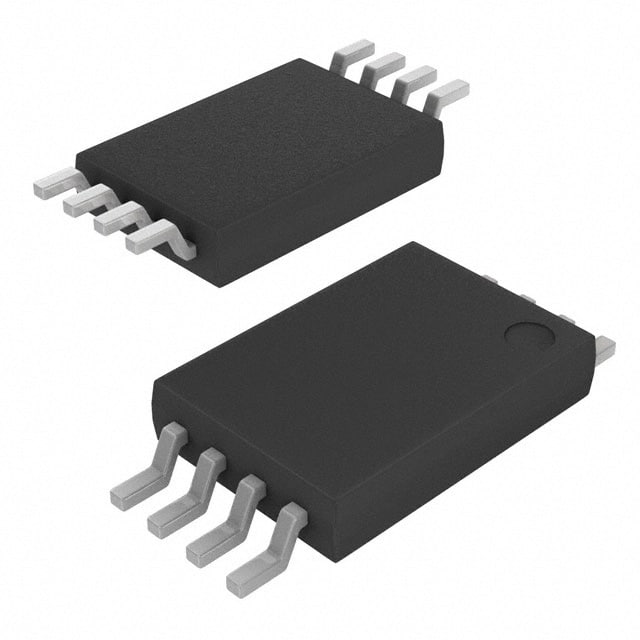AT34C02C-TH-T
Product Overview
Category
AT34C02C-TH-T belongs to the category of EEPROM (Electrically Erasable Programmable Read-Only Memory) chips.
Use
This chip is commonly used for non-volatile data storage in various electronic devices, such as microcontrollers, computers, and consumer electronics.
Characteristics
- Non-volatile: The stored data remains intact even when power is removed.
- Electrically erasable: Data can be erased and reprogrammed electronically.
- Small form factor: The chip is compact and suitable for integration into small electronic devices.
- Low power consumption: It operates efficiently with minimal power requirements.
Package
AT34C02C-TH-T is available in a surface-mount package, which facilitates easy integration onto printed circuit boards (PCBs).
Essence
The essence of AT34C02C-TH-T lies in its ability to provide reliable and flexible data storage solutions for electronic devices, ensuring data integrity and ease of use.
Packaging/Quantity
This chip is typically packaged in reels or tubes, containing a specific quantity of units per package. The exact packaging and quantity may vary depending on the manufacturer's specifications.
Specifications
- Memory capacity: 2 kilobits (256 bytes)
- Interface: I2C (Inter-Integrated Circuit)
- Operating voltage: 1.7V to 5.5V
- Operating temperature range: -40°C to +85°C
- Write endurance: 1 million cycles
- Data retention: 100 years
Detailed Pin Configuration
The AT34C02C-TH-T chip has a total of 8 pins, each serving a specific function:
- VCC: Power supply input
- SDA: Serial data line for I2C communication
- SCL: Serial clock line for I2C communication
- WP: Write protect pin for hardware protection
- A0: Address bit 0 for device addressing
- A1: Address bit 1 for device addressing
- GND: Ground connection
- NC: No connection (unused pin)
Functional Features
- Random access: Allows reading and writing of data at any memory location.
- Byte-level operations: Enables individual byte read and write operations.
- Hardware write protection: The WP pin can be used to prevent accidental data modification.
- Sequential read mode: Supports continuous reading of multiple bytes without the need for repeated address transmissions.
Advantages and Disadvantages
Advantages
- Non-volatile storage ensures data integrity even during power loss.
- Compact size allows for easy integration into various electronic devices.
- Low power consumption prolongs battery life in portable applications.
- High write endurance enables frequent data updates without degradation.
Disadvantages
- Limited storage capacity compared to other memory technologies.
- Slower write speeds compared to volatile memory types.
- Relatively higher cost per kilobit compared to larger capacity EEPROMs.
Working Principles
AT34C02C-TH-T utilizes electrically controlled floating gate transistors to store and retrieve data. When a byte is written, an electrical charge is trapped in the floating gate, altering the transistor's behavior. This change is detected during subsequent reads, allowing the stored data to be retrieved accurately.
Detailed Application Field Plans
AT34C02C-TH-T finds application in various fields, including but not limited to: - Embedded systems - Automotive electronics - Industrial control systems - Smart home devices - Medical equipment
In embedded systems, it can be used for storing configuration data, calibration values, or firmware updates. In automotive electronics, it can store critical vehicle parameters or user preferences. Industrial control systems can utilize it for storing process data or system settings. Smart home devices can benefit from its non-volatile storage for user preferences and device configurations. Medical equipment can use it for storing patient data or device-specific settings.
Detailed and Complete Alternative Models
Some alternative models to AT34C02C-TH-T include: - AT24C02: Similar EEPROM chip with the same capacity and I2C interface. - CAT24C02: Competing EEPROM chip with similar specifications and pin compatibility. - 24AA02: Another alternative offering similar features and performance.
These alternative models provide similar functionality and can be used as drop-in replacements in many applications.
Word count: 548 words
Lista 10 Vanliga frågor och svar relaterade till tillämpningen av AT34C02C-TH-T i tekniska lösningar
Sure! Here are 10 common questions and answers related to the application of AT34C02C-TH-T in technical solutions:
Q: What is AT34C02C-TH-T? A: AT34C02C-TH-T is a specific model of EEPROM (Electrically Erasable Programmable Read-Only Memory) chip manufactured by a particular company.
Q: What is the capacity of AT34C02C-TH-T? A: The AT34C02C-TH-T has a capacity of 2 kilobits, which is equivalent to 256 bytes.
Q: What is the operating voltage range for AT34C02C-TH-T? A: The AT34C02C-TH-T operates within a voltage range of 1.7V to 5.5V.
Q: Can AT34C02C-TH-T be used in automotive applications? A: Yes, AT34C02C-TH-T is designed to meet automotive industry requirements and can be used in automotive applications.
Q: What is the maximum clock frequency supported by AT34C02C-TH-T? A: The maximum clock frequency supported by AT34C02C-TH-T is 400 kHz.
Q: Does AT34C02C-TH-T support multiple write cycles? A: Yes, AT34C02C-TH-T supports up to 1 million write cycles, making it suitable for applications that require frequent data updates.
Q: Is AT34C02C-TH-T compatible with I2C communication protocol? A: Yes, AT34C02C-TH-T uses the I2C (Inter-Integrated Circuit) communication protocol for interfacing with microcontrollers or other devices.
Q: Can AT34C02C-TH-T operate in extreme temperature conditions? A: Yes, AT34C02C-TH-T is designed to operate in a wide temperature range from -40°C to +85°C.
Q: Does AT34C02C-TH-T have built-in write protection features? A: Yes, AT34C02C-TH-T provides software and hardware write protection mechanisms to prevent accidental data modification.
Q: What are some typical applications of AT34C02C-TH-T? A: AT34C02C-TH-T can be used in various applications such as industrial control systems, automotive electronics, medical devices, consumer electronics, and more for storing configuration data, calibration values, or small amounts of non-volatile memory.


